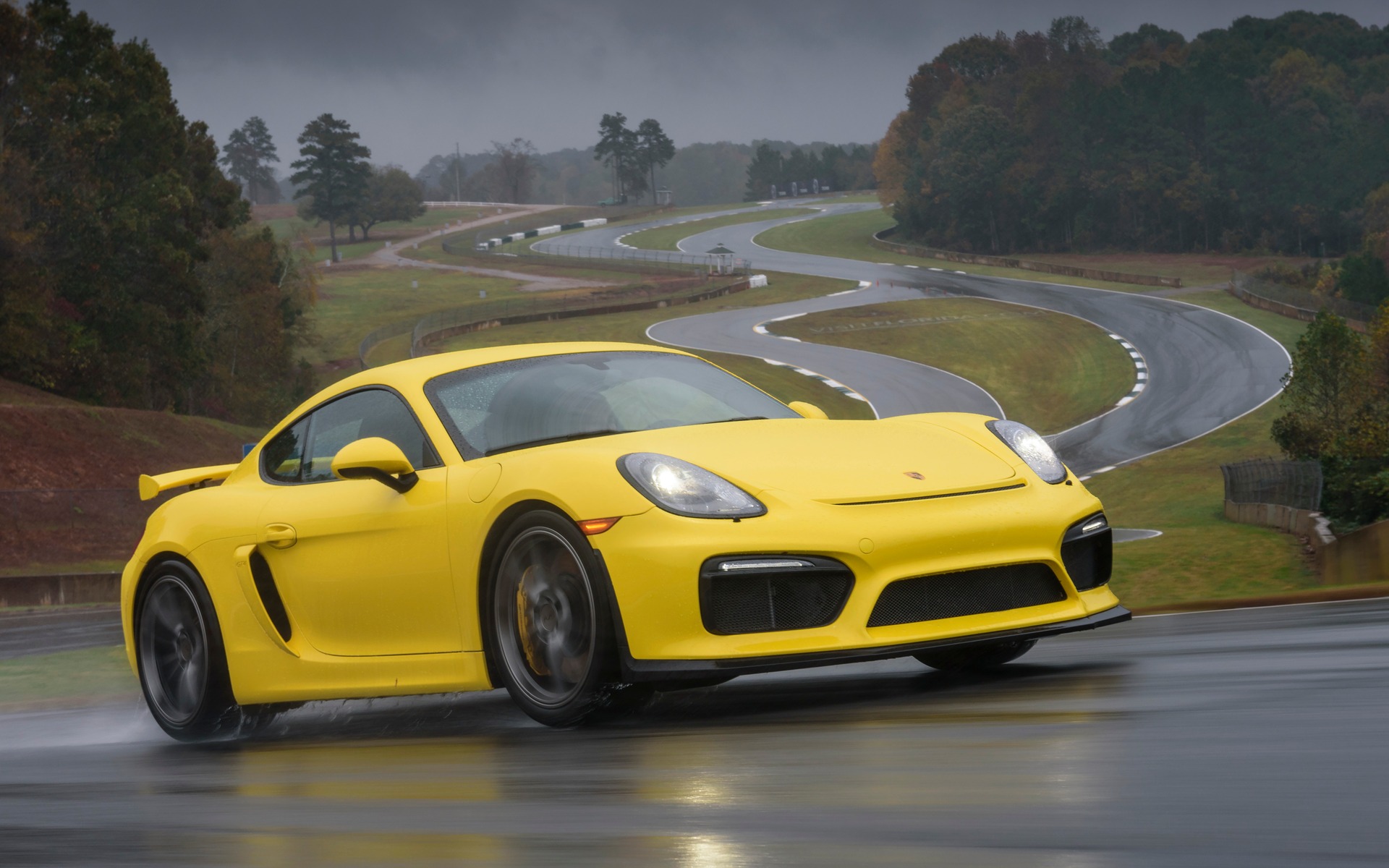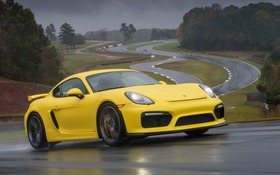2016 Porsche Cayman GT4 And 911 GT3 RS: Track Bred

| Strong points |
|
|---|---|
| Weak points |
|
Porsche recently introduced a higher-spec version of the GT3, called the GT3 RS, as well as a new high-performance variation of the Cayman, called the GT4. Both of these GT cars are focused primarily on the racetrack, so we were invited to Road Atlanta to sample each one. Unfortunately it rained on our parade of Porsches during our track test, though that didn’t put a damper on the fun.
GT4: A Cayman built for speed
Driving. If you’re reading this review it’s because you like it. In fact you love it. You love getting behind the wheel and being at the edge of control. You love the feedback the steering wheel transmits through the palms of your hands, and the sound the engine makes as you feed it commands through your right foot. You love getting planted in the seat by G forces as you accelerate and negotiate turns. And you love doing this on a racetrack.
- Also: 2016 Porsche GT3 RS And Cayman GT4: We’re Driving Them This Week
- Also: 2016 Porsche Cayman GT4: The Ultimate Cayman
If these sensations appeal to you, then you will be totally enthralled with the 2016 Cayman GT4. Despite being Porsche’s entry-level GT car, it is designed with serious performance driving in mind.
It’s the first time that Porsche has added a GT suffix to the Cayman name since it was introduced a decade ago. But it’s not just a cosmetic overhaul that distinguishes the GT4 from its other Cayman brethren. No, the GT4 is much more than that. To put it simply: It is the fastest Cayman the German carmaker has ever offered. According to Andreas Preuninger, the man behind all of Porsche’s GT cars, it is faster around a racetrack than the more powerful and more expensive Carrera S.
To do this, it first gets a larger engine than any other Cayman model. Its 3.8-litre six is sourced from the Carrera S, but uses a lighter flywheel and develops 385 horsepower, which is good enough for a 0-100 km/h time of 4.4 seconds. Because its makers claim that the GT4 is heavily focused on the driving experience, it comes exclusively with a six-speed manual gearbox.
When asked why a PDK gearbox is not available in the GT4 (not by me, I have no problem handling a stick), Preuninger said, “We lost some purists,” referring to the introduction of the latest GT3, which is available only with PDK. The only driver assist you’ll find hides behind the Sport button on the centre console, whose only purpose is to activate a rev-matching function that blips the throttle when downshifting.
Front suspension components were lifted from the GT3, and it sits 30 mm lower and is firmer than the Cayman GTS. The brakes, too, are borrowed from the GT3, both the standard 380 mm steel items, or the optional, larger ceramic brakes ($8,450). To enhance racetrack grip, the bodywork can generate up to 100 kg of downforce.
There’s no elegant way to slip into the GT4 when it is equipped with the optional full bucket seats, as were fitted to my test car ($5,400). These seats are designed to hold you still at racetrack speeds, and have only fore and aft adjustment. Although the interior includes all the amenities you’d need for the commute to work, like an audio system and air conditioning, Porsche would gladly delete these luxuries at no extra cost.
GT3 RS: No holding back
The first GT3 RS saw light in 2003, and this latest one is the fifth iteration of this “RennSport” special. To get a Porsche with an even greater focus on track driving than the 2016 GT3 RS you’d have to get a GT3 Cup racer. This is the Porsche you’ll want if fast lap times are your priority. For $50,000 above the price of a GT3, the $200,700 GT3 RS will lap the Nurburgring five seconds quicker than the GT3.
Speed enhancing trickery includes ample use of carbon fibre (hood, front fenders, rear decklid, rear wing, etc.), a magnesium roof (lighter than carbon fibre), and bodywork that can generate up to 350 kg of downforce. Front and rear tracks are wider than the GT3, and of course, it’s more powerful. Propelling the RS is a 4.0-litre, 500-horsepower naturally aspirated flat six, and the only gearbox available is a 7-speed PDK. The zero to 100 km/h time is 3.3 seconds.
Inside you’ll find the same carbon-fibre bucket seats that come in the 918 Spyder. And reaffirming its racing pedigree is the Pit Stop button that maintains a preset speed to adhere to pit-lane speed limits. It’s also equipped with ultra-wide (265/35-20 front; 325/30-21 rear) Michelin Pilot Sport Cup 2 tires. Oh, and it has an electronically controlled locking differential, as well as rear-wheel steering, which varies rear-wheel direction by 3 degrees depending on speed and steering input.
On track
Despite the wet conditions, we were able to attain surprisingly high speeds, partially due to the grip-enhancing downforce each car can generate.
The GT4 felt more nervous—and more visceral—than the GT3. Due to its lighter weight and mid-engine layout, it turned in quicker but felt twitchier on the wet pavement. Its manual gearbox is a benchmark for precision, with short, positive lever throws and a responsive clutch. The rev-matching function eliminates the need for heel-toe downshifts, but if you’re one of those purists who balked at the PDK-only GT3, you can turn it off and heel-toe to your heart’s content.
The GT3 RS on the other hand felt planted and stable. Although turn in was slower than the GT4, there was no lack of steering precision. It also felt heavier, not surprising considering the GT4 undercuts the GT3 RS by 80 kilos.
Aside from seat-compressing acceleration, the GT3 RS has one of the best dual-clutch gearboxes I’ve had the pleasure of experiencing. I shifted manually using the steering wheel paddles, and gear changes were lightning-quick, with no delay between finger commands and gear changes. Gear changes at high revs returned an angry yet rewarding jolt through the seat, almost in celebration of the oncoming higher speeds. And from the cockpit, the high-pitched engine wail only served to accentuate the driving experience, a true aural delight.
Porsche takes track driving seriously, and with the GT3 RS and GT4, the German company has exemplified its focus on the driving enthusiast. A salesperson will gladly point you to a Panamera if you’re looking for coddling comfort, or a Macan if you want to carry supplies to the cottage.
These are focused track tools, not poser cars, and if you buy either one, you cannot exploit its potential unless you take it to a closed course. But, like I said, if you’re reading this, you’re a driving fanatic, so I don’t think you’d have it any other way.











